Fixing an Overheating Laptop
I've been having some trouble with my Lenovo T400 laptop recently. When under a heavy load, such as playing a game or watching a full-screen video on YouTube, the computer would spontaneously shut down without warning. I finally got fed up when it happened while playing a game, causing the saved game to become corrupted and losing several hours of progress. I had seen these kinds of spontaneous shutdowns before on a desktop, which I eventually traced to an overheating graphics card, but had never seen this show up on a laptop before. Still, suspecting some overheating, I decided to investigate
Some Background
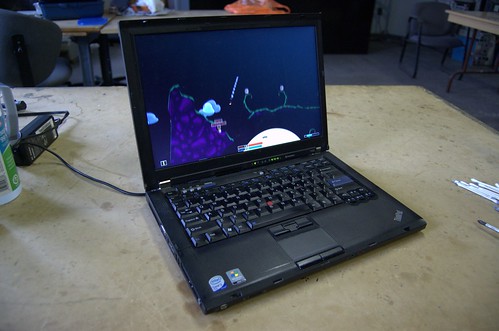
The first thing I tried was turning off the video card to try and reduce the amount of heat inside. Since I can't just remove the card like in a desktop machine, I found a BIOS setting that allowed me to disable the discrete graphics card and run the Intel integrated graphics only. I booted up and tried playing a game, but within 5 minutes the system had failed again.
The next thing I tried was running a program called HWMonitor from CPUID. HWMonitor collects all kinds of handy information about your computer, from the temperature of the CPU to the capacity of the battery, letting you quickly identify thermal issues on a machine. Running HWMonitor and starting a game, I saw the CPU temperature jump up from around 55 celsius to 86 celsius. Playing for a bit longer, I eventually saw the CPU temperature break the 90 degree mark.
Some additional background for people unfamiliar with heating issues in computers: The processor (CPU) in a modern computer is hot. Hot enough that if uncontrolled, the CPU could likely get hot enough to melt itself, if it weren't for the built-in thermal protection circuits. Modern CPUs measure their temperature, and if things get hot enough to cause damage, will automatically shut itself down for safety. I don't know what that threshold is, but from my previous experience with some overheating video cards, I've noticed that seems to happen around 90 degrees celsius.
Generally, CPUs are kept cool by attaching a big metal block (heat sink) to the processor. The metal block is shaped into fins, which increases the total surface area of the block, and allows the surrounding air to more easily absorb heat from the heat sink. Usually there will also be a fan that continuously blow the warm air away from the heat sink, since cooler air is better at absorbing heat. In between the heat sink and the processor, a conducting putty (thermal compound) is used as a kind of seal to help the heat flow from the processor into the heat sink.
I suspected the cooling fan was not running at a proper speed. Normally, HWMonitor can measure the speed of a system fan in RPM, but it seems to be incompatible with the fan controller in the Lenovo T400. I blew some compressed air into the vent to try and clear out any dust, but it didn't have a noticable effect. With nothing else to try, I decided to pull off the heat sink, clear off the crappy thermal compound that manufacturers like to use, and apply some high-quality Arctic Silver Ceramique, to see if that would help.
The Repair
I started by disconnecting the laptop from the A/C adapter and removing the battery for safety.
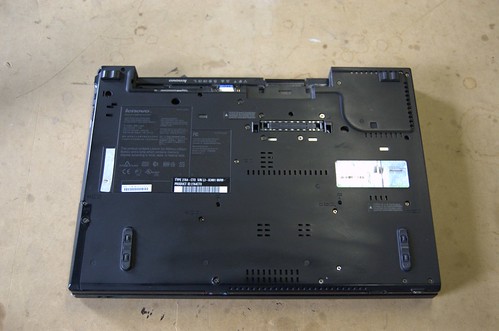
Disassembly of the T400 requires removing 5 screws from the underside. The 5 screws are labelled with pictures of the keyboard, trackpad, and/or memory.
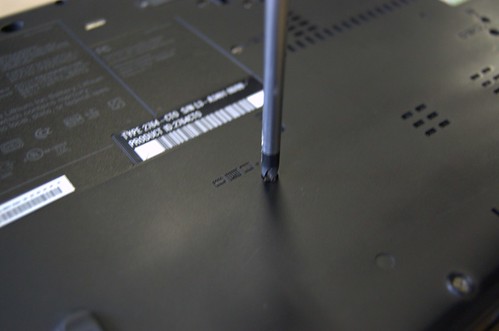
I flipped the machine right-side-up, and pulled away the trackpad from the chassis.
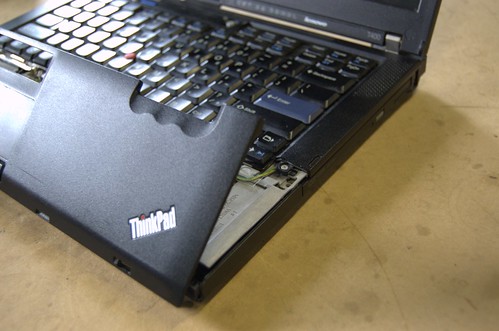
With the trackpad removed, the keyboard lifts right up.
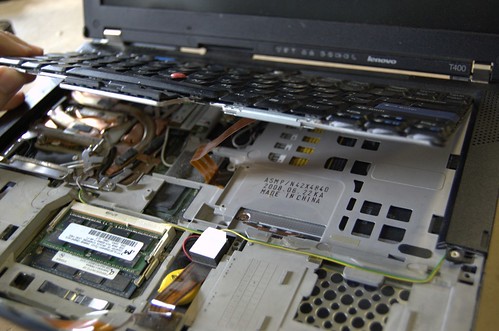
There is a ribbon cable connecting the keyboard to the main circuit board of the laptop. I disconnected it, and set the keyboard aside.

There is another ribbon cable connecting the trackpad to the main board. I pulled this one out as well, and set the trackpad with the keyboard.

The thin black plastic shield that covers the speakers and runs across the back of the laptop is held in by three screws, and some troublesome plastic clips. It needs to be carefully pried away from the chassis to remove it.

With the shield removed, the left speaker needs to be unscrewed (2 screws) to get full access to the heat sink assembly.

The heat sink assembly is held in by six screws in total - 4 around the CPU, 1 near the southbridge, and 1 above the GPU, near where the LCD connects to the circuit board. Minding the wires for the Bluetooth modem and antenna cables for wifi and GSM, the heat sink can now be lifted up and removed from the chassis, revealing the CPU, GPU, and southbridge.

In the above picture, the grey goo is thermal compound. You can see that it has oozed all over the CPU and GPU, meaning way too much compound was used. The compound that is on there is no good, so I removed it from both the heat sink and processors using isopropyl alcohol and a cotton swab. Cotton swabs aren't ideal for this kind of work because they tend to leave little fibres behind, but I didn't have anything else handy.

I removed all the old thermal compound, revealing the mirrored finish of the GPU.

Finally, I applied the Arctic Silver Ceramique to the processors. A good rule of thumb is to apply a blob of compound that is about the size of half a grain of cooked rice. I used a bit more on the southbridge to get good coverage. The goal is to cover as much of the metal as possible without having any compound ooze out the side.

I put everything back together, powered up, and booted into Windows. Checking HWMonitor, I saw that the CPU was sitting around 40 degrees celsius, meaning I hadn't screwed up anything too badly. The next test was to try out a game. After a few hours, there was no crash, and the highest recorded CPU temperature was 60 degrees celsius. Mission accomplished!